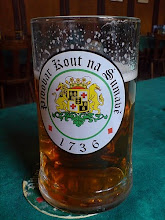 There are many places in Bergen where it is worth sitting down enjoying a beer. One of them can be found not far from the wharf. On the hillside above the Maria church and Bergenhus castle you can find Bar Barista. This is a combination of a neighbourhood pub and an ordinary taproom in a cosy environment.
There are many places in Bergen where it is worth sitting down enjoying a beer. One of them can be found not far from the wharf. On the hillside above the Maria church and Bergenhus castle you can find Bar Barista. This is a combination of a neighbourhood pub and an ordinary taproom in a cosy environment. Unfotunately Bar Barista does not sell beer from draught. Every beer inside is available only in bottles and cans. The reason for this is that the bar is somewhat new, and that the owners so far have not made draught beers available. By the way, the beers are accompanied by a good selection in wines and spirits.
Unfotunately Bar Barista does not sell beer from draught. Every beer inside is available only in bottles and cans. The reason for this is that the bar is somewhat new, and that the owners so far have not made draught beers available. By the way, the beers are accompanied by a good selection in wines and spirits. Once upon a time the Øvregaten street was the mainstreet of Bergen. Just below you could find the harbour where salesmen traded with fishermen and hanseatic travellers. These days this is the outskirts of the city centre, but for tourists Øvregaten is easy to find as it is in a short distance from the cruise liners' harbour.
Once upon a time the Øvregaten street was the mainstreet of Bergen. Just below you could find the harbour where salesmen traded with fishermen and hanseatic travellers. These days this is the outskirts of the city centre, but for tourists Øvregaten is easy to find as it is in a short distance from the cruise liners' harbour.
Bar Barista can be found in the street above Øvregaten. After a short walk the bar is easily located in the Stølegaten street. It is like a hole in the wall in its street. The local 7-Eleven takes up a lot of room around the bar and can unfortunately outshine it in its neighbourhood.
 Inside, Bar Barista is a cosy place. Coffee lovers will find a lot of coffee variations, and cake lovers can have a good time eating themselves through the sweet offers. But I am here to drink beer, and an old favourite is available in bottles. Good, old Newcastle Brown Ale is sold here, and it is the same half-sweet ale. Not the best British ale, but still a good offering. The local Hansa version of Brown Ale is also to be found, but compared to the Newcastle Brown Ale this is a half good variation with less taste.
Inside, Bar Barista is a cosy place. Coffee lovers will find a lot of coffee variations, and cake lovers can have a good time eating themselves through the sweet offers. But I am here to drink beer, and an old favourite is available in bottles. Good, old Newcastle Brown Ale is sold here, and it is the same half-sweet ale. Not the best British ale, but still a good offering. The local Hansa version of Brown Ale is also to be found, but compared to the Newcastle Brown Ale this is a half good variation with less taste. Hansa Bayer is a nice offering at Bar Barista, and the Baviarian style beer is both tasty and very drinkable. So is also the Hansa draught beer (fatøl) from cans, but its sugary tones makes it a number 2 beer compared to the Bayer.
Hansa Bayer is a nice offering at Bar Barista, and the Baviarian style beer is both tasty and very drinkable. So is also the Hansa draught beer (fatøl) from cans, but its sugary tones makes it a number 2 beer compared to the Bayer.Bar Barista is a nice place to have a beer or five. The lack of draughted beers makes the bar less interesting than it ought to be, but an excellent interior and fine paintings on the wall make a good effort. You could do worse in Bergen than visiting Bar Barista, but in the meantime this is a great place for some local Hansa beers - even though only from bottles and cans.














































